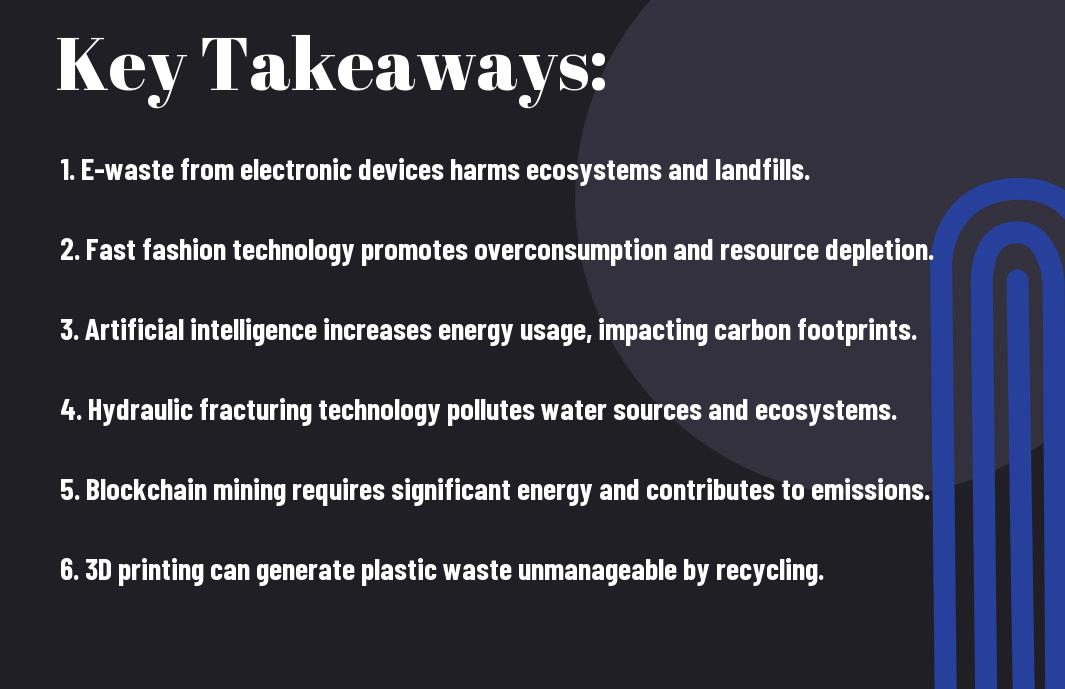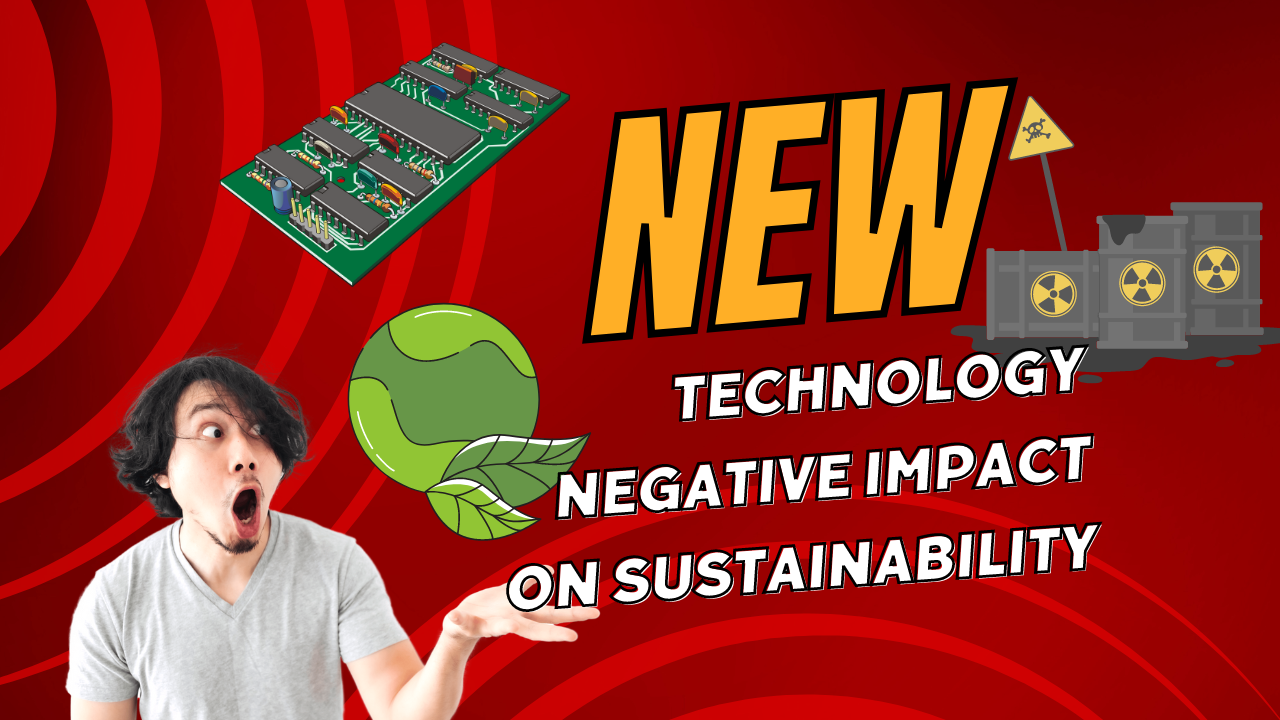new technology having a negative impact on sustainability As I probe into the world of innovation and progress, I’m often reminded that not all advancements are created equal. While technology has the potential to revolutionize the way we live and work, I’ve come to realize that some of the latest developments can have unintended consequences on our planet’s sustainability. In fact, I’ve noticed that certain new technologies can actually exacerbate environmental issues, rather than alleviate them. In this post, I’ll explore a specific example of how new technology can have a negative impact on sustainability, and what it means for your daily life and the future of our planet.
Table of Contents


The Dark Side of Progress
Your excitement about the latest smartphone or electric vehicle might be tempered when you consider the unintended consequences of these technological advancements. As I examine into the darker aspects of innovation, I want to highlight the often-overlooked negative impacts on sustainability.
Unintended Consequences of Technological Advancements
Darker realities lurk beneath the surface of progress. The rapid pace of technological innovation can lead to unforeseen effects, such as increased energy consumption, e-waste generation, and resource depletion. These consequences can have far-reaching and devastating implications for the environment.
Environmental Degradation Caused by New Technologies
On the surface, new technologies may seem like a panacea for our environmental woes, but they often contribute to the very problems they aim to solve. For instance, the production of solar panels and wind turbines requires the extraction of rare earth metals, which can lead to soil pollution and water contamination. new technology having a negative impact on sustainability
Unintended environmental degradation can also result from the disposal of these technologies at the end of their life cycle. The lack of standardized recycling practices for electronic waste, for example, means that toxic materials like lead and mercury can leach into soil and waterways, posing a significant threat to ecosystems. As I explore the complexities of sustainability, it becomes clear that even the most well-intentioned innovations can have hidden costs.
The Rise of E-Waste

As I research into the world of sustainability, I’m struck by the stark reality of e-waste’s devastating impact on our planet. The rapid pace of technological advancements has led to an unprecedented growth in electronic waste, and it’s imperative that we acknowledge the consequences of our actions.
The Growing Problem of Electronic Waste Disposal
The sheer volume of discarded electronic devices is staggering. Every year, millions of tons of e-waste are generated, with a significant portion ending up in landfills or incinerators. This not only wastes valuable resources but also contaminates soil and water, posing a significant threat to human health and the environment.
Toxic Chemicals and Their Impact on the Environment
Rise of e-waste has also led to an alarming increase in toxic chemicals released into the environment. These hazardous substances, such as lead, mercury, and cadmium, are found in electronic devices and can have disastrous consequences when not disposed of properly. new technology having a negative impact on sustainability
1k Subscribers on YouTube Salary per Day
Impact of these toxic chemicals on the environment is far-reaching. When e-waste is burned or dumped, these chemicals leach into the soil and water, contaminating ecosystems and wildlife habitats. For instance, lead, a common component in electronics, can cause neurological damage and birth defects in humans. Moreover, the release of these toxins also contributes to climate change, further exacerbating the environmental crisis. As consumers, it’s necessary that we recognize the consequences of our actions and take responsibility for the electronic waste we generate.

The Unsustainable Nature of Fast Tech
All around us, we’re surrounded by the latest and greatest gadgets, devices, and innovations. But beneath the shiny surface of these advancements lies a darker truth: the unsustainable nature of fast tech.
The Environmental Cost of Rapidly Obsolete Devices
Consequences of our addiction to fast tech are staggering. The constant stream of new devices, designed to be used for a short period before being discarded, has led to an unprecedented amount of electronic waste. I’m sure you’ve experienced it yourself – a phone that’s barely two years old, but is already considered outdated, or a laptop that slows down significantly after a few months of use.
The Social Implications of Planned Obsolescence
To make matters worse, this rapid obsolescence is often deliberate, designed to drive sales and boost profits. As a result, we’re conditioned to believe that our devices are no longer good enough, that we need the latest model to stay relevant.
Implications of this mindset are far-reaching. We’re not only contributing to the staggering amounts of waste, but also perpetuating a culture of disposability, where things are used once and then discarded without a second thought. This attitude seeps into other areas of our lives, influencing how we approach consumption, relationships, and even our own identities. As I reflect on my own relationship with technology, I realize that I’ve fallen prey to this mindset, constantly feeling the pressure to upgrade, to keep up with the latest trends. And I’m sure you have too. new technology having a negative impact on sustainability
Conclusion
With these considerations, I am reminded of the rise of fast fashion e-commerce, which has led to an unprecedented surge in carbon emissions and waste generation. As you scroll through your social media feeds, you’re likely to come across influencers promoting trendy outfits, often worn once and discarded. Your clicks and purchases fuel this unsustainable cycle, contributing to the staggering 12.8% of global greenhouse gas emissions attributed to the fashion industry. It’s a sobering example of how new technology can have devastating environmental consequences when not harnessed responsibly. new technology having a negative impact on sustainability
FAQ
Q: What is an example of new technology having a negative impact on sustainability in the field of e-waste?
A: A significant example of new technology having a negative impact on sustainability is the rapid obsolescence of smartphones and laptops, leading to a massive generation of electronic waste (e-waste). The constant release of new models with incremental upgrades and the pressure to keep up with the latest trends have resulted in millions of devices being discarded annually, contributing to the already overwhelming e-waste problem. This not only harms the environment but also wastes valuable resources, as many of these devices still have functional components that could be repurposed or recycled. Furthermore, the mining of rare earth metals and other materials required for the production of these devices has devastating environmental and social consequences, including deforestation, water pollution, and exploitation of workers.
Q: How does the increasing popularity of fast fashion and online shopping contribute to unsustainable practices, and what role does technology play in this issue?
A: The rise of fast fashion and online shopping has led to an unprecedented surge in textile waste, with the average American generating 82 pounds of textile waste per year. Technology plays a significant role in this issue, as it enables the rapid production and distribution of cheap, trendy clothing. Social media platforms and influencer marketing also fuel the desire for constant newness, driving consumers to purchase more and discard old items quickly. Moreover, the convenience of online shopping has led to a culture of overconsumption, with many shoppers buying items they may not need or wear, only to return them or discard them shortly after. The environmental impact of this trend is staggering, with the production, transportation, and disposal of these garments contributing to greenhouse gas emissions, water pollution, and waste management issues.
Q: What is the environmental impact of cryptocurrency mining, and how does it relate to the broader discussion of technology’s sustainability?
A: Cryptocurrency mining, particularly Bitcoin, has been criticized for its enormous energy consumption and carbon footprint. The process of mining involves solving complex mathematical equations to validate transactions, which requires powerful computers that consume vast amounts of electricity. It’s estimated that Bitcoin mining alone uses over 73 TWh of electricity annually, comparable to the energy consumption of a small country like Belgium. This energy demand is largely met by fossil fuels, contributing to greenhouse gas emissions and climate change. The environmental impact of cryptocurrency mining serves as a stark reminder of the unintended consequences of emerging technologies and the need for sustainable design and practices in the development of new innovations.


Pingback: How to download Windows 10 ISO directly from Microsoft homepage - Torq Blog